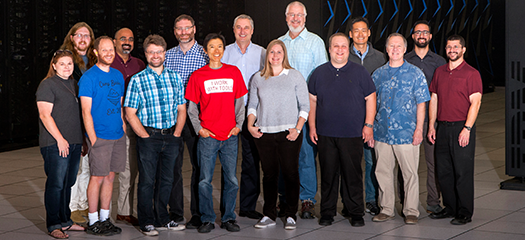Our scientific application developers, software engineers, and similar career types have one thing in common: they’re people who are passionate about pushing the boundaries of scientific discovery; proactively combating disease; enhancing security in our own community, across our nation, and internationally; and blazing a path forward for clean, sustainable energy.
Our work doesn’t get boring. Our developers create highly complex physics models, visualization codes, and other unique applications that are tailored to specific research requirements. They write scientific software applications that evolve predictive science, unlock nature’s secrets via materials science simulations, provide insight into global warming, and prepare for natural disasters. They also develop and integrate components, such as Web-based user interfaces, access-control mechanisms, and commercial indexing products, to create operational information and knowledge discovery systems.
As valued contributors of multidisciplinary teams, our software, network, and applications specialists are part of a project’s entire lifecycle, from establishing the vision to developing the solution. The jobs are varied, but the common purpose is to develop and deploy production-quality software systems and networking solutions that enhance the nation's security. For example:
- Develop flexible, efficient, parallel frameworks for multiphysics codes on advanced computing platforms (including exascale platforms), as well as the analysis of the large data sets generated by these simulations.
- Design software for developing and interrogating important material properties, as well as designing and controlling experiments and facilities.
- Provide high-quality information systems that contribute to prevention, detection, and response with respect to the capabilities and intentions of potential proliferators.
- Develop and integrate components needed to create knowledge discovery systems.
- Create and support compilers and preprocessors, and debugging, memory, profiling, tracing, code correctness, and performance analysis tools that run on the world’s fastest and most productive computer systems.
- Prevent network exploitation by building and testing the equipment necessary to establish a test lab.
- Develop security plans and teach others about the importance of compliance.
Job satisfaction is extremely important to us, and we have mechanisms that allow our employees to move easily between jobs without losing benefits or interrupting service years. You can pursue several different careers in Computing and never leave the company because of the enormous set of complex scientific problems being addressed by the Lab. You can work on the world’s largest laser, develop modeling and simulation codes, work on the world’s fastest computer, or tackle myriad challenges to make the world a safer place. This flexibility sets Computing apart from our competitors.
One software developer, who left LLNL Computing for a Silicon Valley start-up only to return a few short years later, compared the two work experiences: "For awhile, it was great to work at the start-up where I could focus on one project without interruptions; life was simple. But working on only one project with the same five people day in and day out gets really boring. I got restless. I now have a better understanding of and appreciation for what I want the content of my job to be."




